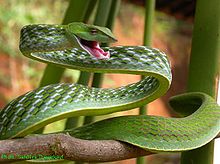- Ahaetulla nasuta
-
Green vine snake or Long-nosed Whip Snake 

Scientific classification Kingdom: Animalia Phylum: Chordata Class: Reptilia Order: Squamata Suborder: Serpentes Family: Colubridae Subfamily: Colubrinae Genus: Ahaetulla Species: A. nasuta Binomial name Ahaetulla nasuta
(Lacépède, 1789)Synonyms Dryophis nasuta
Dryophis mycterizansThe Green vine snake (Ahaetulla nasuta), is a slender green tree snake found in India, Sri Lanka, Bangladesh, Myanmar, Thailand, Cambodia and Vietnam.
Contents
Description
The green vine snake is diurnal and mildly venomous. The reptile normally feeds on frogs and lizards using its binocular vision to hunt. They are slow moving, relying on camouflaging as a vine in foliage. The snake expands its body when disturbed to show a black and white scale marking. Also, they may open their mouth in threat display and point their head in the direction of the perceived threat. There is a widespread myth in parts of southern India, that the species uses its pointed head to blind its human victims.
The species is viviparous, giving birth to young that grow within the body of the mother, enclosed within the egg membrane. They may be capable of delayed fertilization (parthenogenesis is rare but not unknown in snakes) as a female in the London zoo kept in isolation from August, 1885 gave birth in August, 1888.[1] The venom is mild and causes swelling. Symptoms will subside within three days.[2]
Taxonomic description
- See snake scales for terminology used
 Eating a skink, Ristella travancorica
Eating a skink, Ristella travancorica
The following description with diagnostic characters is from Boulenger (1890):[3]
Snout pointed, terminating in a dermal appendage, which is shorter than the eye and formed entirely by the rostral; the length of the snout, without the appendage, about twice the diameter of the eye or rather more. No loreal; internasals and prefrontals in contact with the labials; frontal as long as its distance from the rostral or a little longer, as long as the parietals or a little longer; two preoculars and a small subocular (or one preocular and two suboculars), upper preocular in contact with the frontal; two postoculars; temporals 1+2 or 2+2; upper labials 8, fifth entering the eye; 4 lower labials in contact with the anterior chin-shields, which are shorter than the posterior. Scales in 15 rows. Ventrals 172-188; anal divided; subcaudals 140-166. Bright green or pale brownish, the interstitial skin between the scales black and white on the anterior part of the body, which appears striped when distended; a yellow line along each side of the lower surface. Total length 5 feet: tail 2.
Notes
- ^ Wall, Frank 1905. A popular treatise on the common Indian snakes. Part 1. J. Bombay Nat. Hist. Soc. 16:533-554.
- ^ Snakes of Sri Lanka
- ^ Boulenger, George A. 1890 The Fauna of British India, Including Ceylon and Burma. Reptilia and Batrachia. Taylor & Francis, London, xviii, 541 pp.
References
- Lacepède, B. G. E. 1789 Histoire Naturelle des Quadrupèdes Ovipares et de Serpens. Vol.2. lmprimerie du Roi, Hôtel de Thou, Paris, 671 pp.
- Wall,F. 1908 Remarks on some recently acquired snakes. J. Bombay N. H. S. xviii: 778-784
- Wall 1908 A new color variety of the common green whip-snake (Dryophis mycterizans). J. Bombay N. H. S. xviii: 919
- Wall,F. 1910 Remarks on the varieties and distribution of the common Green Whip Snake (Dryophis mycterizans). J. Bombay nat. Hist. Soc. 20: 229
- Wall 1910 Varieties of the common Green Whip Snake (Dryophis mycterizans). J. Bombay nat. Hist. Soc. 20: 524
Categories:- Colubrids
- Fauna of Southeast Asia
- Reptiles of Thailand
Wikimedia Foundation. 2010.


